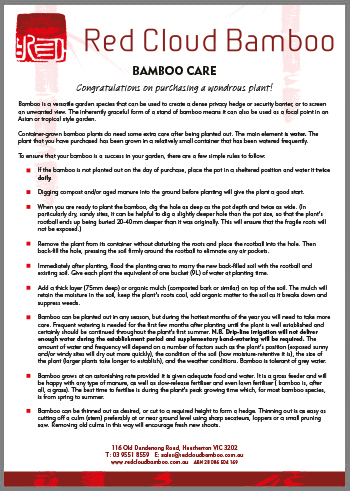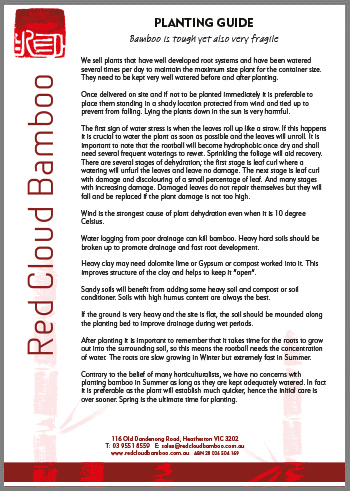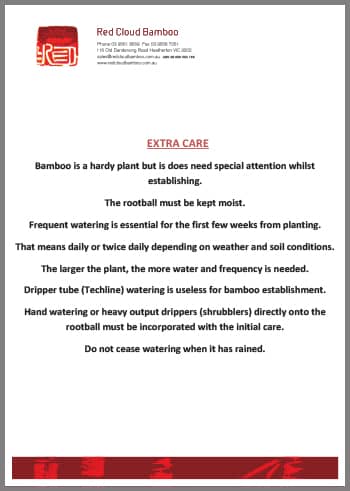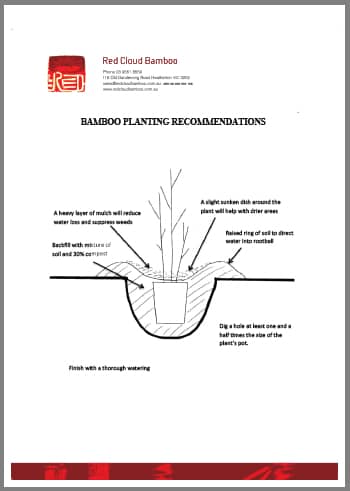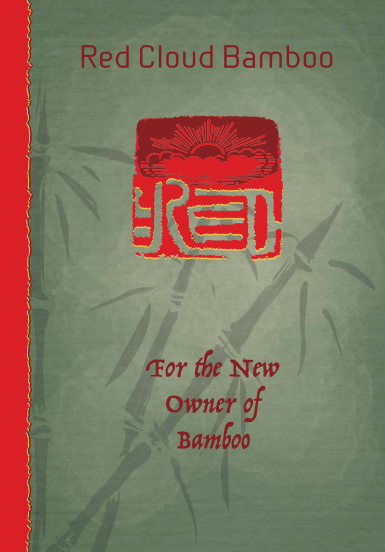Everything You Need to Grow with Confidence
Everything You Need to Grow with Confidence
Whether you're new to bamboo or ready to plant your tenth screen, this section covers everything you need to know. From choosing the right variety to long-term maintenance, we’ve pulled together our most useful guides in one place.
Downloadable Guides:
Frequently Asked Questions
From spacing and pot sizes to invasive species and costs, this section answers the questions we hear every week. Sample answers include:
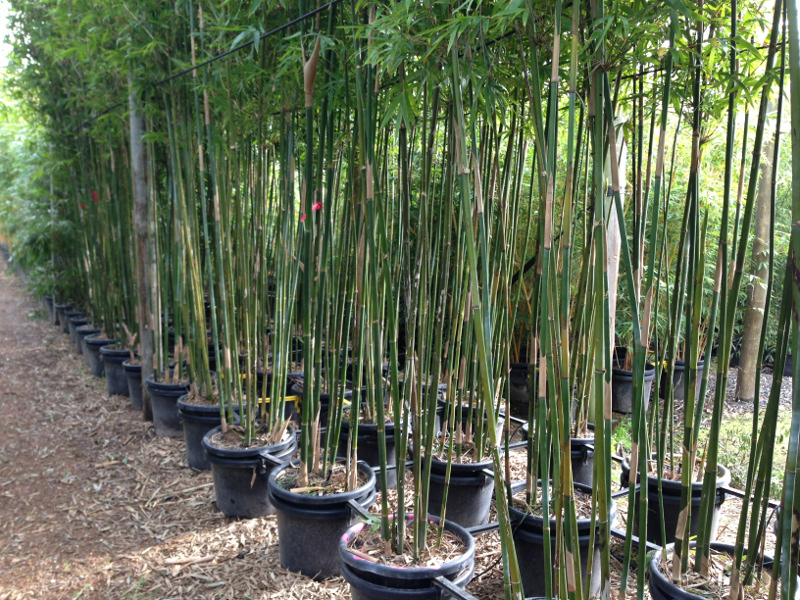
It is true. Melbourne has been cursed with the highly invasive Golden Bamboo for many decades now. If it is planted with no boundaries it will fulfil its duties to invade the whole area. However this is a good looking indestructible plant, fantastic for screening or even a stand alone specimen plant in just about any conditions. If planted in a controlled area and inspected every few months for rhizomes escaping, you will not have any problems with it. Clumping variety bamboos are just that, they form a clump and do not run away. Over several years several bamboo enthusiasts have imported these clumping varieties from all over the world. Many people do not understand that there is such a bamboo plant that is non invasive. In fact, clumping bamboo is far less intrusive than most trees and shrubs that are planted in any garden. Bamboo has a fine surface root system that will not seek out drain pipes and block them.
Planting bamboo is a truly rewarding experience. Each year, the new generation of culms (canes) typically doubles in size—both in height and diameter—until the plant reaches maturity. Smaller varieties reach full size in about 3–4 years, while larger species take 5–6 years. After that, the plant will continue to produce shoots of consistent size annually, influenced only by factors like water, temperature, and humidity.
As a clump matures, it gradually expands outward as new shoots appear around the base. While all clumping bamboos stay relatively contained, some varieties form much wider clumps than others. Choosing the right species is essential—especially in tight spaces like garden beds along driveways, where a clump that grows 2 metres wide might be less than ideal.
Propagation is slow and demanding. It can take up to three years before a bamboo is ready for sale in a 200mm pot. And unlike many plants, bamboo doesn’t look its best in a nursery pot—often appearing leggy, with little foliage. But below the surface is a dense, fibrous root ball, storing energy for rapid growth after planting.
This tight root mass can dry out quickly. Regular watering directly onto the root ball is essential in the first few weeks after planting—sometimes multiple times daily. Once roots establish in the surrounding soil, bamboo becomes no more water-hungry than other plants. However, for best performance, keep soil consistently moist and feed with a high-nitrogen fertiliser.
One of the best all-rounders for Australian gardens is Gracilis. Fast-growing and elegant, it can reach 6 metres in just two seasons and offers that classic upright bamboo look. It’s also highly versatile—perfect for screening two-storey buildings or easily maintained at 2 metres with pruning.
- Light: Bamboo needs plenty of natural light, but not direct sunlight through glass, which can scorch leaves.
- Soil: Requires a well-draining, nutrient-rich mix that holds moisture without becoming soggy.
- Watering: A fine balance. Too much water leads to root rot; too little dries the plant out quickly—both are harmful.
- Humidity: Bamboo thrives in high humidity, but indoor air in places like Melbourne is typically quite dry.
- Air Flow: Fresh, circulating air is essential. An open window nearby helps reduce fungal and pest issues.
- Pests: Indoor bamboo is prone to issues like spider mite, scale, and mealy bug, especially in low-airflow environments.
Light: lots of natural light, but not direct sun through glass.
Soil: an open mix which holds moisture and nutrients.
Watering: very difficult to retain the right amount of moisture content in the soil. Over watering will damage a plant quickly, drying out will damage it even quicker.
Humidity: indoors in Melbourne is usually dry air. Bamboo loves high humidity.
Air flow: an open window nearby is very beneficial
Bugs: thrive on an indoor plant. Spider mite, scale, mealy bug, etc.
Grow at your own will!
 Non-invasive
Non-invasive Easy to manage
Easy to manage Perfect for residential landscapes
Perfect for residential landscapes
 Can spread aggressively
Can spread aggressively Requires root barrier or open space
Requires root barrier or open space Not recommended for suburban gardens
Not recommended for suburban gardens
- Rhizome
The underground stem from which culms, roots, and new rhizomes grow. The growth type (clumping vs. running) is determined by the rhizome structure. - Culm
The upright, woody stem of the bamboo—commonly referred to as the "canes" or "stalks". - Shoot
A young culm as it first emerges from the ground, pushing upward during the growth season. - Node
The visible “rings” or joints along a culm. These separate the internal compartments and provide structural strength. - Internode
The hollow segment between two nodes. The length of internodes varies by species. - Culm Sheath
These are the protective bracts (leaf-like covers) that wrap around young shoots as they grow. They support and protect the culm until it hardens. Once the culm reaches its full height, these sheaths naturally fall away.
(Fun fact: Culm sheaths are a great aid in species identification—though that’s a deep dive for another day!)

